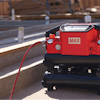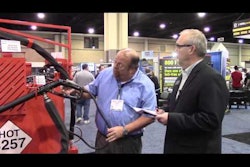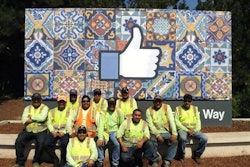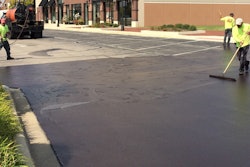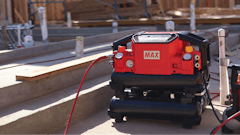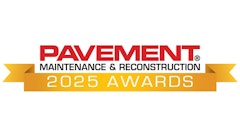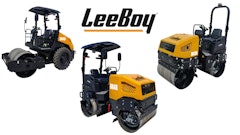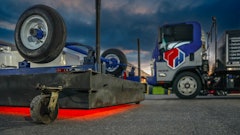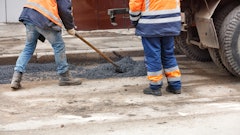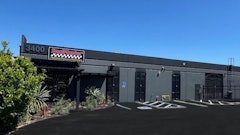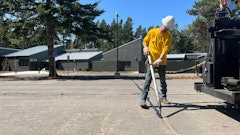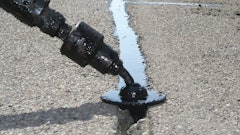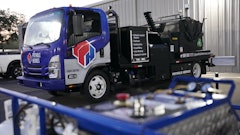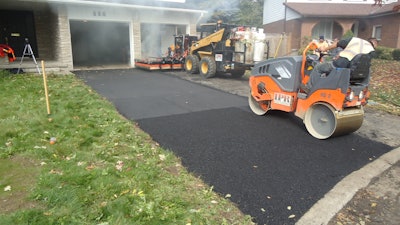
Contractors are faced with risks to their safety on every jobsite, every day. From traffic control to the equipment they operate, workers need to be fully aware of their environments at all times. When working with infrared asphalt heating equipment, contractors may think safety is a no brainer compared to other jobs, but there are still things they need to consider in order to complete the safest job possible.
"Infrared is not intrinsically more dangerous than crack sealing, sealcoating or spray patching," says Rob Holden with Heat Design Equipment. "Most IR equipment tends to be fueled by propane so there is a certain awareness operators should have that they should observe when working around any combustible fuel or material. There are hot surfaces involved as well, again not dissimilar to other practices, so crews should be aware of this and exercise good judgement and wear the appropriate clothing, eye protection and other PPE. Obviously when workers fail to follow health and safety regulations, operating instructions or choose to behave inappropriately, then accidents will happen."
“The biggest thing to remember is that equipment does not have a brain,” says Cliff Cameron with KM International. “If operators understand their equipment and keep safety in the forefront of everything they do, then they minimize the potential for any adverse conditions. 99% of all accidents and incidents are related to human error and can be avoided if people slow down and evaluate what they are doing.”
Experience is Key
Giving operators the tools they need to succeed with this equipment is the first step. Infrared machines heat asphalt to upwards of 350°F. These extreme temperatures can pose potential dangers to inexperienced operators.
“One of the biggest dangers of infrared is turning someone who just bought equipment out into the repair market without training,” Cameron says. “A dangerous situation exists when a newer owner takes on more than his experience allows for. KM International always recommends receiving training when anyone buys one of our machines. During our training we go over all safety precautions on the machine and make sure the user has a full understanding on how to operate the machine in a safe manner. If no on-site training is received, we always talk to the customer over the phone or via email to ensure they understand the equipment fully and can keep themselves and their crew safe.”
Training will help you to get to know your machine and what areas you need to watch out for so always abide by the warning labels on the machine. Manufacturers design their infrared a little different so the areas that get hot are a little different depending on the machine, but those areas are always have the proper warning labels.
"Any equipment or process that is not operated responsibly or within the regulations and manufacturers guidelines represents a hazard," Holden says. "Safety starts with the individual. All manufacturers of equipment and the AED strive to inform operators and users of the best practices to reduce the possibility of accidents."
“Worksite dangers they are pretty minimal if you take a common sense approach to everything you do,” Cameron says. “The machine is heating the asphalt to a temperature of 350°F, so of course some areas of the machine will be hot. “Be sure to allow proper cool down time before touching the hot points on the machine.”
Creating a Safe Repair
Another safety consideration is the condition of the pavement to be repaired. Not all failures can be repaired safely using infrared and the repairs must be done properly to ensure a lasting and safe patch.
“The infrared units out there are only great machines when the crews operating them have good skills in raking luting and rolling,” Cameron says. “These same crews must have common sense when it comes to identifying repairs to be made with the infrared asphalt recyclers. Cutting corners and not rejuvenating the repair can result in compromised asphalt repairs.
“The process is either a good process or a bad process based on the crew performing the work. If the job is done right and the repair is long lasting then the infrared process will get a good name. However, if it is done wrong and the crew chooses not to follow the process to the letter, then repairs fail and the infrared process is “NO GOOD.” It is the responsibility of every owner to ensure people are trained to maximize their potential as in any process. If we all make it our mission to train and do the best job every time then together we can perpetuate the infrared industry and give a great end product to all the customers around the world.”
Keeping Traffic Out
Not only is an infrared repair safer than saw cut and replace repairs using fresh asphalt, but they also take about a third of the time as repairs can be opened to the traveling public much sooner. However, it’s still important for the safety of your crew and the initial patch to keep cars away from where you’re working.
“Keeping large, moving objects away from workers and working area is always a must,” says Krystal Strassman with Asphalt Reheat Systems. “Set up the work area with proper notice before unloading equipment and starting the work is key to keep your workers safe from the traveling public.
“Use proper barricades and set up warning signs to divert traffic well in advance with cones and directional lights. Be extra cautious on a hill where you are not as easily visible.”
"Depending upon the jobsite, traffic control measures will vary," Holden says."You're are in the business of repairing and maintaining pavement, so traffic is an ever present hazard. Most jurisdictions have well defined traffic control regulations and recommendations and the crew and management needs to be aware of these and comply with them. On non-public areas then the principles of the on-road regulations should be applied as best as possible in the circumstance while workers are present."
Infrared also does not involve a lot of equipment so the traffic control plan for these repairs is also much easier.
“Saw cutting, removal and replacement processes take saws, big truck coming in and hauling asphalt away and bring new asphalt in,” Cameron says. “Those jobs use big rollers, 4-6 man crews while infrared takes 1/3 the time and two guys.
“Traffic for these jobs can be redirected for approximately 20-30 minutes per repair. On straight away repairs the traffic can resume immediately after the area is cleaned up. On turns you will want to give the repair about 30-45 minutes to avoid rutting.”
Holden says another thing to consider is pedestrian traffic. "Pedestrian traffic, though a reduced hazard for workers is another ever present responsibility when working in a public space," Holden says. "Just as you wouldn’t allow a passer-by to stroll across a factory floor, this is a work place and restrictions need to be put into place to protect everyone that is likely to interact with it."
Keeping these things in mind can help ensure the safety of your crew, the traveling public and also the finished repair.
“Infrared repair is not rocket science, but it is an art,” Cameron says. “The proper training will help the user perfect that art and ensure they are performing both safe and proper infrared repairs.”


